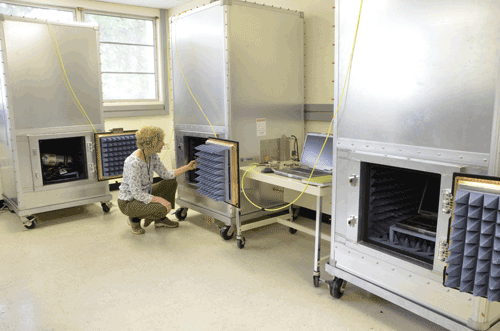New performance standards enable RF emergency devices
Researchers in PML’s Electromagnetic Division (part of NIST) have worked with the National Fire Protection Agency (NFPA) to develop test methods that can verify the performance of wireless devices that are used in emergency situations. Such a device is the PASS (personal alert safety systems) which is used by firefighters and integrates a transmitter that sends a signal back to the base station when the firefighter is motionless for 30 s.

Fig. 1: Researcher Kate Remley examines the middle chamber containing a repeater unit in a “one- hop” communications test. The PASS is in the cabinet at left, and the base station is in the cabinet at right.
Now the PML has developed test methods for point-to-point signal attenuation, as well as for interference effects between PASS units and wireless devices that operate in the same frequency bands, such as radio-frequency identification (RFID) systems. They have been approved for the proposed 2013 revision of NFPA's PASS standard, however NFPA will vote on whether to adopt the revised standard in October 2012. If it does, it will be the first time that new RF technology is included in the NFPA standard, and will likely pave the way for development of future RF devices.
In a firefighter’s surroundings, a major challenge is attenuation or path loss. Low attenuation exists when the signal travels through a few walls (such as in a residential structure or office building) before reaching the base station. But the majority of emergency situations require signals from a portable PASS device to travel through thick walls, which produce high attenuation.
The tests are performed in two anechoic chambers: one houses the portable PASS unit mounted on a typical backpack-type air supply; the other contains the base receiver station. The PASS devices transmits its signal from within the first chamber. The signal is picked up by an antenna in that chamber and transmitted through a coaxial cable to a broadcast antenna in the second chamber, where the base station picks up the signal.
The test operators can introduce precise amounts of attenuation and/or interference into the system. The process is fully controllable while also effectively simulating conditions in the field (such as in buildings, tunnels, the New York City subway, and skyscrapers). Data taken from NIST field measurements were used to calibrate the settings for the anechoic chambers.
Two-legged transmission is used in PASS communications. For example, when a firefighter goes in a building or underground location, his portable devices send a signal to a stationary repeater (placed at the entrance of the building or underground site), which than sends a signal to the base station.
These systems are tested with a “single-hop” attenuation test that is being develop by the RF Fields Group’s Metrology for Wireless Systems Project with leader Kate Remley (see Fig. 1 ). For this test setup, the PASS device, repeater, and base station are each placed in three anechoic chambers, connected to one another by cable, and appropriate amounts of attenuation are introduced between the chambers for each hop.
The PASS signals are usually generated in the 900-MHz or 2.4-GHz band, which many consumer wireless devices also use and therefore may interfere with PASS performance. Interference signals with the same frequency band are fed into the chamber through one side of a power divider connected to the anechoiic chamber.
Because wireless transmitters interact with reflections off of metallic surfaces, the team has started to develop test setups for that as well. One- and two-hop attenuation methods and testing that involve both hops and reflection are being developed now and will be mostly useful for emergency teams that are called into subways or other underground environments where the attenuation is high and trains and tracks can cause reflection.
Christina Nickolas
Advertisement
Learn more about National Institute of Standards and Technology





